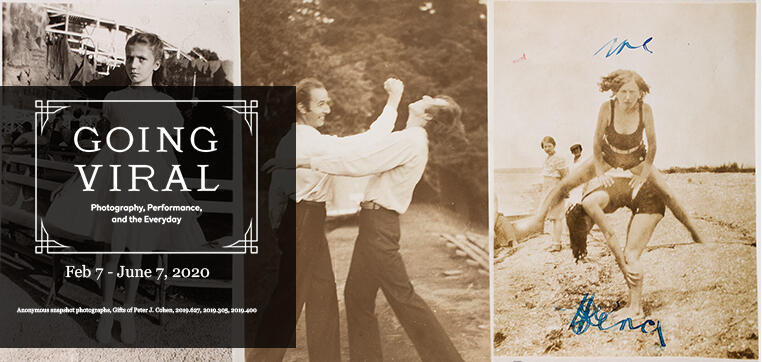The Davis Museum is closed for Wellesley College’s winter break. Please join us at our spring opening celebration on February 5, 2026, at 4 pm.

Visit the online version of the exhibition here.
Today, we use the phrase going viral to describe the rapid reception and reproduction of media on the Internet. However, since the dawn of amateur photography in the late-nineteenth century, critics have warned of a “universal snapping psychosis.” Long before the age of the selfie, the craze for candid cameras spawned innumerable tropes that snapshooters found irresistible. This exhibition of early-twentieth-century American snapshots considers our everyday relationship to photography: the ways in which we mediate, understand, and narrate our lives through the snapping and sharing of photographs, and how and why certain types of images become socially infectious.
In addition to serving as personal mementos, snapshots are objects of material culture produced in accordance with social norms and public expectations. The happy couple is documented cutting the cake on their wedding day, a family commemorates a trip to Paris with a photo in front of the Eiffel Tower, or a little girl twirls in her new dress for the camera. Mined from the Peter J. Cohen Collection gift of nearly 1,000 anonymous snapshots, the exhibition is organized into eleven sections that explore various performances, rituals, and gestures that have gone viral via photography: Viewing Vistas, Monuments Men, Showing Skirts, Fake Fighting, Cross Dressing, Snapping Shadows, Pyromania, “Me,” The Ends, Costumes & Caricatures, and Pictures of People Taking Pictures. The texts for each section provide micro-histories of these diverse social phenomena and demonstrate how vernacular photographs might function as affective historical documents. A single image of two men, fists aimed at each other in a classic pugilist pose, cannot tell us much about the circumstances under which the exact photograph was snapped. But hundreds of examples that depict variations on the same theme? They promise rich rewards for the imaginative historian, anthropologist, or sociologist.
In addition to the 123 snapshots on view, the exhibition will also showcase an Original Kodak camera, early amateur photography manuals, Kodak 1s and 2s, twentieth-century album pages, and six photo albums. The exhibition concludes with the latest from Kodak—the Printomatic—which will allow visitors to shoot and print their own snapshots in the gallery.
We invite you to share your own snapshots and impressions with us on social media using #davisgoingviral
Curated by Carrie Cushman, Linda Wyatt Gruber '66 Curatorial Fellow in Photography, the exhibition is supported with funds given through the generosity of Linda Wyatt Gruber (Class of 1966) and Wellesley College Friends of Art at the Davis.